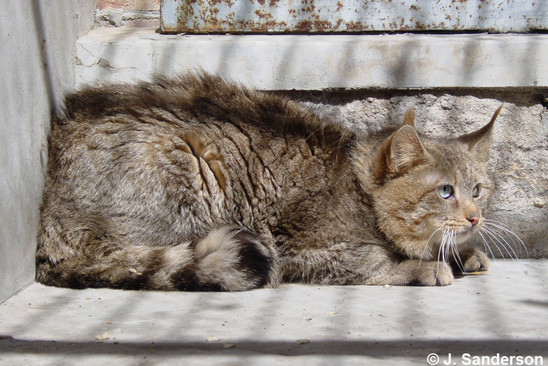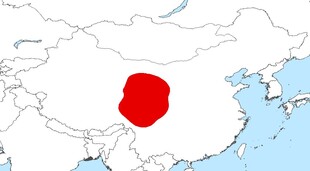Chinese mountain cat
Felis bieti
IUCN Red List: Vulnerable
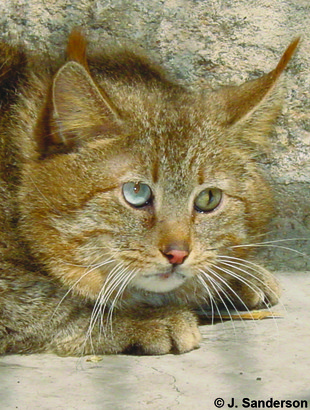
| Weight: | 5.5-9 kg |
| Body length: | 60-85 cm |
| Tail length: | 29-35 cm |
| Longevity: | unknown |
| Litter size: | 2-4 cubs |
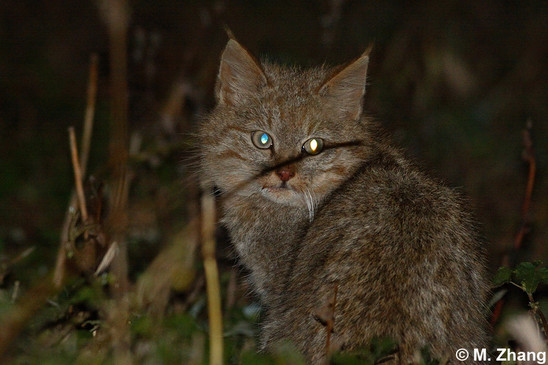
Description
The Chinese mountain cat (Felis bieti), traditionally called Chinese desert cat, is one of the least known cat species.
Although the taxonomy of the Felis complex and thus the taxonomy of the Chinese mountain cat has not yet been fully resolved and agreed on, the Chinese mountain cat is currently considered to be a seperate species of the European wildcat (Felis silvestris) and the Afro-Asiatic wildcat (Felis lybica) and recognised as a monotypic species.
The Chinese mountain cat has a stocky build and relatively short legs. In the Tibetan highlands it is called “grass cat” by the local people since its fur matches so closely the colour of dry grass. The fur of the Chinese mountain cat is greyish in winter and dark brown in summer. Its sides, legs and cheeks are marked with faint brown horizontal lines. The lower lips, chin and belly are white and the throat appears pale yellowish brown. The ears are tipped with tufts of dark brown fur and the back of the ear is pale yellowish brown. The tail of the Chinese mountain cat is fairly bushy making up about 40% of the cat’s total body length The last part of its tail is encircled by three to six dark rings with a black tip.
Language/Country | Name |
|---|---|
Chinese | o mao, huang mo mao, cao shihli |
English | Chinese Desert Cat, Chinese Mountain Cat, Chinese Alpine Steppe Cat, Chinese Steppe Cat, Grass Cat |
French | chat de Biet |
German | Graukatze |
Kazakh | shel misigi |
Spanish | gato de Biet, gato del deserto de China |
Uygur | qel müshüki |
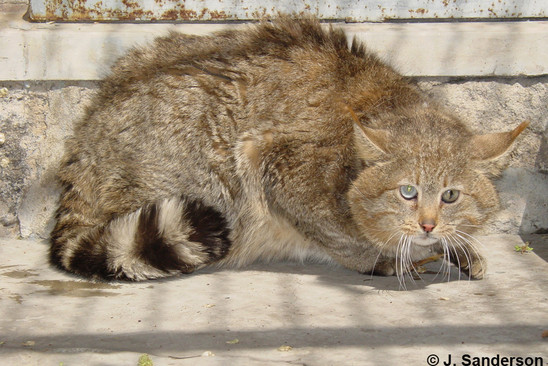
Status and Distribution
The Chinese mountain cat is the least numerous of the wildcats and classified as Vulnerable by the IUCN Red List. The National Red List of China’s Vertebrates lists is as Critically Endangered. It is endemic to China and has a restricted distribution only occurring on the eastern Qinghai-Tibet plateau. It is thought to occur in 67 counties within the provinces of Qinghai, Gansu, Sichuan and Tibet Historic reports from the province of Xinjiang, Ningxia and Inner Mongolia are now either attributed to Asiatic wildcats or domestic cats, or could not be verified.
Very little information is available about its abundance, and its population trends and status remain unknown. Generally, the Chinese mountain cat is considered to be rare and its effective population size may be fewer than 10,000 mature individuals. It is thought that it is declining across its range and may be fragmented, too.
Habitat
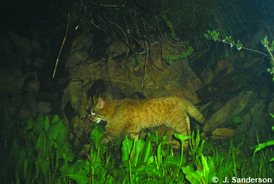
The Chinese mountain cat occurs at high altitudes and in areas with harsh climatic seasonal extremes. The climate can be dry, windy and very hot to very cold. The Chinese mountain cat inhabits steppe grasslands at high elevations, alpine meadows and alpine shrubland. Sometimes it is also found in hilly loess steppe and edges of coniferous forests. In Xinlong County, Sichuan Province, it was also pictured in mixed forest. It has never been recorded in deserts. The Chinese mountain cat occurs primarily in alpine meadow habitats at elevations of 2,500 to 5,000 m.
Ecology and Behaviour
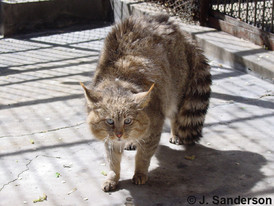
There is little information available about the Chinese mountain cat’s ecology, spatial arrangements, habitat requirements and behaviour. The Chinese mountain cat seems to be solitary and mostly active at night or crepuscule. During the day it rests in burrows excavated by marmots or badgers where it also gives birth and rears its kittens. Most of such burrows used by Chinese mountain cats have been found on south facing slopes and some at elevations of 3,600 m.
The mating season is thought to take place in January-March and most litters are born in May. At 7-8 months cubs become independent. Male and female Chinese mountain cats are solitary except during the breeding season. The Chinese mountain cat hunts mole rats by listening for their movements through their subterranean tunnels (3-5 cm below the surface), and then digging them out.
Prey
Rodents are the major prey of the Chinese mountain cat. They take mainly mole rats, white-tailed pine vole, and pikas. Lagomorphs and birds such as pheasants and partridges are also taken. The Chinese mountain cat most probably also scavenges.
Main Threats
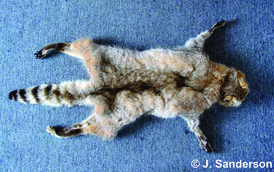
- Fur of a Chinese mountain cat.
Large scale poisoning campaigns have been conducted since 1958 in China in an attempt to control “pest” populations of voles, moles and pikas which are viewed as grazing competitors of domestic livestock. Studies have shown, however, that the problem of pest outbreaks results from overgrazing and that an important way to combat this problem would be to avoid overgrazing as well as to have a healthy population of predators. Nonetheless, today, control programmes using poisonous chemicals continue throughout much of the Chinese mountain cat’s range and have eradicated pikas from large areas. Such prey base depletion is one of the main threats to the Chinese mountain cat. Applied chemicals can also lead to secondary poisoning in the predators such as the Chinese mountain cat. Another threat is the hunting of its fur, which is mostly used locally for making traditional hats and clothing. The large scale open trade is closed, but it still occurs at unknown and unregulated level so that Chinese mountain cats furs are still found in the illegal wildlife trade.
Additionally, the Chinese mountain cat is threatened by habitat loss from infrastructure development in the region, leading to habitat degradation and fragmentation. Road mortality has also been reported.
A recent study has found raised concerns about the potential of genetic introgression from domestic cats. Although the study had only found a widespread signal of genetic admixture from the Chinese mountain cat in the domestic cat, it shows the potential of gene flow in the opposite direction. If this occurs, it may potentially disrupt the genetic integrity of the Chinese mountain cat.
Conservation Effort and Protection Status
The Chinese mountain cat is included in Appendix II of CITES. It is fully protected in China. In 1992, the Chinese mountain cat was recommended to be upgraded to Appendix I of CITES by the Cat Specialist Group, which would require permission of national, rather than provincial authorities to hunt or trade it. This recommendation has not yet been implemented.
Research on the status and distribution of the Chinese mountain cat is urgently needed as well as further studies about its ecology and demography to be able to identify major threats and take efficient conservation measures. Moreover, the effectiveness of protected area management to protect the species should be assessed.
